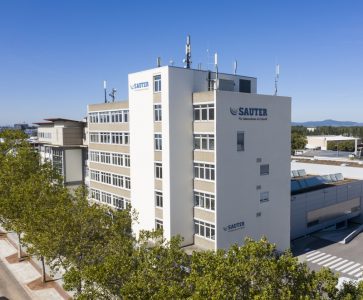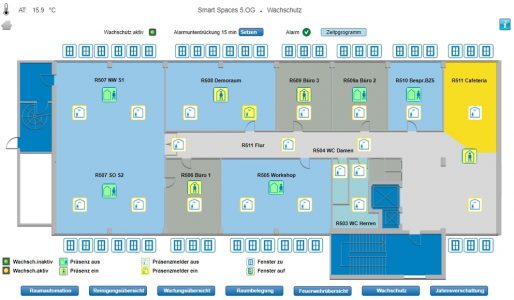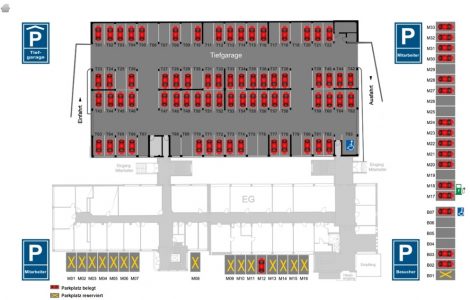Modular principle for digital building automation
Issue :
read all articles online
read as pdf
The demand for smart building solutions is growing continuously. Along with basic needs such as heating, cooling and shading, options such as demand-dependent cleaning and maintenance as well as workplace finders are also gaining in importance. SAUTER, the medium-sized specialist, showcases different application scenarios in its new “Smart Spaces” demonstration floors at its company headquarters in Freiburg, Germany.

The technical backbone
The building automation system installed in SAUTER’s Smart Spaces is based on the company’s EY3600, Ey modulo 5 and modulo 6 product families. The integral room automation function essentially consists of SAUTER ecos504 room controllers in preassembled system distributors. The heating, air conditioning and ventilation room disciplines are combined with lighting and sun shielding, making it possible to implement interdisciplinary functions. To this are added EnOcean and KNX multisensors as well as a DALI lighting system and shading with SMI. The SAUTER Vision Center (SVC) gives facility managers the latest visualization interface for building automation. It can be used to visualize, analyze and control all functions installed in smart spaces, including sensors and room occupancy.
Cleaning according to requirements
This approach enables smart spaces to be cleaned as needed. The rooms to be cleaned are integrated by evaluating the presence signal of the EnOcean multisensor, which is identified over time (with a room occupancy of around 3 hours for office/training rooms and approximately 1.5 hours for restrooms) and marked red in the associated SVC floor overview. The lights in the rooms are automatically dimmed to 20 percent, letting the cleaning crew know that the room needs to be cleaned. A sensor-based maintenance overview for restrooms and the cafeteria in SVC also displays the status of towel and soap dispensers as well as the coffeemaker.

The modular system from SAUTER consists of modules for everything from sensor-based analysis of room and parking space occupancy to cloud-based room control.

Monitoring the status of different elements
SAUTER uses an EnOcean-based solution specifically when it comes to monitoring the status of towel and soap dispensers.
While the EnOcean wireless technology used to be employed mainly to distinguish between two states – light switch on/off, window open/closed – or to operate room control panels with a short radio pulse, the towel and soap dispensers are now equipped with a self-powered vibration sensor. When the device is actuated with the preprogrammed intensity, the vibration triggers a counting pulse. When the relevant number of pulses is reached, SVC automatically alerts the FM staff to the need to take action.
Another possible application of the vibration sensors was implemented in the area of desk sharing. In open-plan offices with the freedom to choose a workstation, the office chairs are equipped with EnOcean sensors, which report the occupancy of a desk to the system as soon as an employee sits down on the chair. The SVC user interface thus makes it possible to determine at any time where and how many workstations are available.
SAUTER wants to do more than just demonstrate the possibilities of a modern, smart building with smart spaces. “At the same time, we attach enormous importance to presenting a modular system that lets customers choose whatever they need,” says Werner Ottilinger, Managing Director, SAUTER Germany.
New articles in Smart Spaces
Top articles





